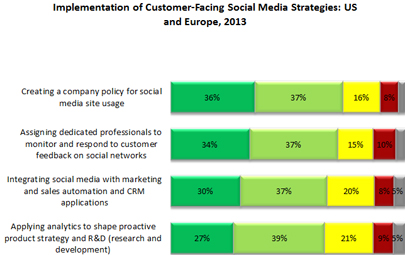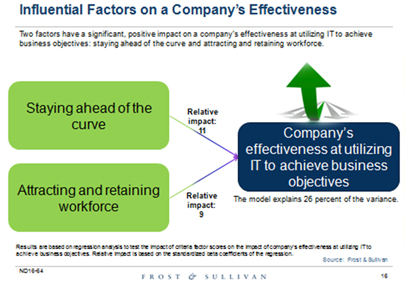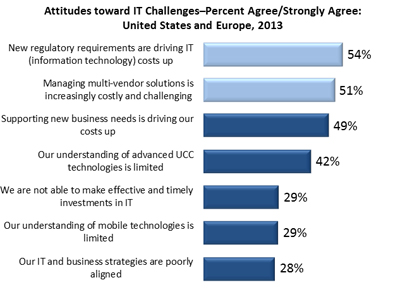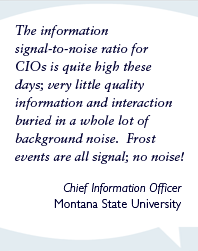|
A recent Frost & Sullivan customer survey of 1,028 IT buyers and influencers revealed much about the changing role of IT and Communications in the U.S. and Europe. The factors driving growth today will surely impact the skills and expertise that IT leaders will need in the future.
Catering to the Need for Anywhere, Anytime Communications and Collaboration
IT leaders must ensure that they take the mobile needs of their workforce into account with every future investment. The following data confirms the rapid growth of mobile devices:
- Nearly three out of every four organizations issue corporate-owned laptops (74%) and smartphones (71%) to their workforces, while almost half issue tablets (47%).
- Almost half (49%) of the survey respondents indicate their organizations are currently using tablets for business purposes.
- 60% of organizations allow personal devices to connect to their corporate network (BYOD).
CIOs need to evaluate the best way to disperse these corporate-owned vs. employee-owned mobile devices, create a policy for personal use regardless of ownership, and integrate them as part of the corporate network. This way, they can ensure sufficient management and security of all the devices floating around their organization.
Consumers Drive IT Decisions – No Longer Does the CIO Rule the Roost
CIOs have not been alone in making IT-related decisions for some time, as CEOs and other company leaders have become part of the decision process. Nonetheless, it is clear that consumer behavior will also drive IT decisions. CIOs must be skillful at listening to employee technology requests, analyzing the true value of those needs to the organization, and effectively communicating their final decisions up and down the chain. Here is some new evidence pointing to this:
- Just a year ago, Android became very popular in the consumer market, but not so in the enterprise. This year’s survey shows that Android has taken a surprising lead as the most common mobile operating system supported for organization-owned devices (at 56%), followed by iOS (41%), Windows Mobile (30%), and BlackBerry (28%).
- Approximately half of the surveyed IT decision makers consider both consumer (external facing) and enterprise social media (internal facing) as highly effective technologies for their companies.
- While the study showed a decline in the use of enterprise videoconferencing over the next few years, 62% of the respondents still agree that it is a highly effective technology for their company. With Skpe and Facetime becoming prevalent in the consumer world, it is likely that the workforce is using these applications as an easy and inexpensive alternative to enterprise-grade videoconferencing.
So what can CIOs do about the above trends? They first need to recognize that consumers will influence vendor R&D decisions. They need to monitor consumer needs carefully before making investment decisions; it’s clear that product preferences can change very quickly.
CIOs can also set the tone for BYOT users; in this way, they can prevent such stopgap measures from doing more harm than good for the organization. They should embrace BYOT (BYOD, BYOA, etc.), because it is the future, but they must also:
- Create a policy for usage
- Ensure security through network, application and device management
- Provide selective access to corporate apps on personal devices
- Protect corporate data and intellectual property and at the same time respect users’ privacy, and
- Provision and manage automation and self-service.
Social Media Tests the CIO’s Business Aptitude
The chart below shows how IT must clearly understand marketing, sales, and R&D goals; implement solutions that provide an acceptable ROI; and ensure that the network remains secure.

How can CIOs help their companies become a social business? They need to:
- Have a clear vision
- Develop a strategy/plan for implementation, user training and education
- Conduct an assessment of social collaboration impact on workflows, processes, procedures, and business culture
- Explore options to integrate social capabilities with other communications apps, and
- Ensure there is management AND user buy-in.
Creating Happy Work Environments
There is much evidence that people are seeking a work/life balance. The slide below shows some powerful data for CIOs – it indicates how important of a role IT has on employee retention.

In addition, the study revealed that social media usage for communications within the enterprise is expected to grow faster than communications with consumers. This again shows how companies are using IT to communicate with their employees. They are using social media to manage project teams, for collaboration, and to deliver corporate communications. All this creates an environment that not only enhances interactions within the enterprise and allows for operations to run more smoothly, but also one that improves camaraderie.
We have all heard of the BYOD trend; now there’s COPE, which means company-owned, personally enabled. This allows employees to use their company-issued phone in a way that personally works for them. We already discussed how CIOs can learn from best practices for implementing such a mobile strategy.
These are some ways that CIOs can help their companies retain and attain high quality employees, and thus achieve a critical business objective. Reducing hiring, firing, and training costs can have a major impact on the company’s bottom line.
More Personalization and Freedom = Higher Need for Network Security
As noted earlier, almost 60% of organizations allow personal devices to connect to their corporate network. However, only four out of ten IT decision makers report that their company has a formal BYOD policy in place. Moreover, 33% of businesses consider BYOD a significant security risk. Adding the dramatic growth of social media and cloud to the mix makes knowledge of network security a critical asset.
Rapid Movement of Enterprise Communications Solutions to the Cloud
CIOs need to create a successful cloud strategy. More than half of surveyed businesses have already moved 50% or more of their enterprise communications solutions to the cloud. Within the next three years, almost a quarter will have moved 76% or more of their communications solutions to the cloud. This is definitely a challenge for CIOs as they must defend and attack through cloud strategies and solutions.
Coping with the Top IT Challenges
With major changes in regulatory requirements in healthcare and finance, this is the #1 IT challenge. The ability to cost-effectively handle these ongoing changes will be a crucial skill for IT in coming years.
The cost and complexity of deploying and managing multi-vendor communications solutions is compelling businesses to consolidate and integrate their disparate platforms and applications or switch to single-vendor communications solutions.
The ability of the CIO to make such changes smoothly and effectively is imperative, especially as this will change the skills needed in the IT department.

Key Takeaways for CIOs and IT Decision Makers
As these technologies and models continue to evolve, the CIO’s role will not go away; rather the skills he/she will need will be much more complex. CIOs must:
- Assess existing assets and IT resources
- Embrace BYOX
- Monitor consumer trends
- Create policies for the use of BYOT and social media
- Ensure network security for new devices, applications, and models
- Defend and attack through cloud strategies and solutions
- Diminish IT costs resulting from dealing with regulatory changes, and
- Effectively manage multi-vendor solution.
Most importantly, CIOs need to become more attuned to the company’s business objectives. Technologies alone don’t solve problems, it’s how effectively they are used that have an impact on the top and bottom line.
|













